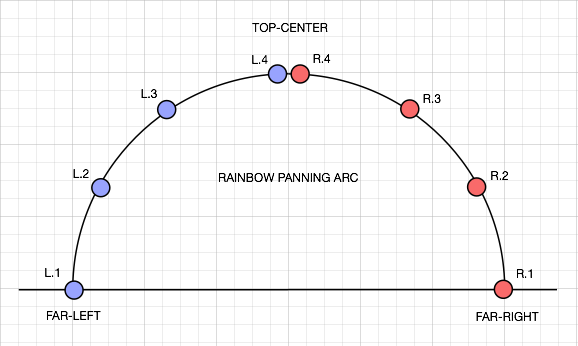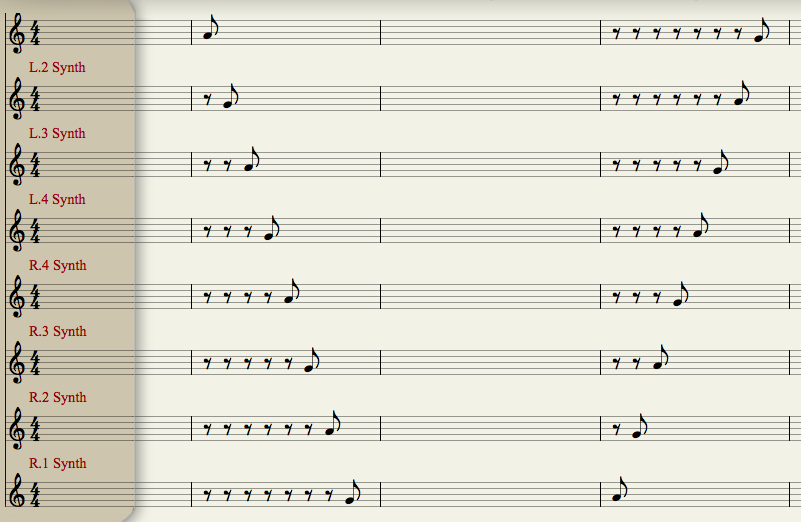There is another aspect, which is very important to understand, and it is that the NOTION 3 bundled instruments are
not VSTi virtual instruments, as is the case with the NOTION 2 bundled instruments. This is done specifically to make it possible to get a full, deep and rich orchestra to fit into a single NOTION 3 score . . .
[
NOTE: The NOTION 3 bundled instruments (N2 and N3) are very nice, but you need a calibrated full-range studio monitor system to get them to sound best when you are mixing and mastering, which is another discussion. They are used in concerts, Broadway plays, and so forth, and all those venues have calibrated full-range sound systems. Some of the VSTi virtual instruments are nice and most of them probably sound better when you listen with commercial-off-the-shelf (COTS) studio monitor systems, but in many respects this is an illusion, because there are no full-range COTS studio monitor systems available anywhere on this planet at the dawn of the early-21st century, which is explained in my ongoing topic in the IK Multimedia FORUM (see below), where the key is to get the Kustom deep bass subwoofers to augment the Kustom PA loudspeakers, and while my guess is that most folks think they are hearing music accurately when they listen to COTS bookshelf studio monitors, but they are vastly deluded, because most of the COTS bookshelf studio monitors will not reproduce the lowest notes on a string bass or electric bass guitar at standard tuning ("Concert A" = 440-Hz) at equal loudness, and some of them only go down as low as 110-Hz, which is the fundamental pitch of the "A" string on an electric guitar and is one octave higher than the "A" string of an electric bass or string bass . . . ]
The Fabulous Affordable Studio Monitor System Project (IK Multimedia FORUM)The problem with VSTi virtual instruments, which includes VST effects plug-ins, is that for all practical purposes all of them are "heavy" in terms of computer resources, and this is particularly important, because NOTION 3 is a 32-bit application both in Mac OS X and Windows, hence it is subject to 32-bit application workspace limitations . . .
VSTi virtual instruments and VST effects plug-ins are loaded into the same 32-bit application workspace as NOTION 3, and the guideline I use here in the sound isolation studio for IK Multimedia VSTi virtual instruments (Miroslav Philharmonik, SampleTank, SampleMoog, SampleTron, and Sonik Synth 2) is that a single NOTION 3 score can handle approximately 20 to 25 staves, and this is the rule I use for Kontakt 5 (Native Instruments), which also is a VSTI virtual instrument . . .
MachFive 3 (MOTU) is extraordinarily "heavy" in terms of computer resources, so I use only 1 or perhaps 2 staves with a MachFive 3 instrument, which reduces the total from (a) 20 to 25 to (b) approximately 10 or 11 . . .
And the way I handle everything is to clone NOTION 3 scores, where I start with a NOTION 3 score and work on its instruments until I am happy with the framework for the song, at which time I do a "Save As" and essentially clone the original NOTION 3 score, where I keep 5 or so staves common in all the clones to serve as a reference point, and this then frees 20 staves for use with other instrument, but as noted when I need to do something with a MachFive 3 VSTi virtual instrument, the total number of staves for the cloned NOTION 3 score is reduced accordingly . . .
This works for me, because by the time I have parts for 20 instruments I know enough about the song only to need a few common instruments to know what to do next in terms of identifying by the common instruments how the measures correspond to verses, choruses, and so forth . . .
And I record the NOTION 3 generated audio as soundbites in Digital Performer 7.24 (MOTU) via ReWire (Propellerhead Software), which works very nicely in Mac OS X, where I also have to combine tracks in Digital Performer 7.24, because it also is a 32-bit application and having more than 50 tracks at a time is a bit much for it to handle, so I merge tracks every so often to free currently dedicated tracks, which basically is the technique that Phil Spector used for his "Wall of Sound" and George Martin used when he was producing the Beatles. It requires a bit more planning, but once you do it a few times, it becomes intuitive . . .
A single song might have as many as 500 to 1,000 instruments, which in turn maps to perhaps 50 cloned and modified NOTION 3 scores, where I keep track of the clones by appending "PT-n" to the name of the file and by keeping all the files in a common folder, where the file names might be {"Song-Pt-1.notion", "Song-Pt-2.notion", . . . , "Song-Pt-n.notion"}. It is a simple strategy, but it works, and once you do it for a few songs, it does not take so much extra time to manage everything, and the basic technique is called "
layering", where a song is composed and constructed in layers, one layer at a time . . .
Regarding the need for 500 to 1,000 instruments, this mostly is because I like to "sparkle" instruments, which is the name I use for the technique where the notes of a single instrument are put into motion across what I call the "Rainbow Panning Arc™" which runs from far-left to top-center to far-right, where if you listen with headphones to the following "sparkled" Psaltery Harp, it will make sense . . .

[
NOTE: This song has three VSTi virtual instruments (a Psaltery Harp, and two synthesized basses), but only the Psaltery Harp is "sparkled". The two synthesized basses are positioned at top-center . . . ]
Music Notation for "Sparkles" -- PDF (89KB, 5 pages)"Sparkles" (The Surf Whammys) -- MP3 (4.3MB, 298-kbps [VBR], approximately 1 minute and 55 seconds)"Full Sparkling" involves having 8 staves, each of which is panned to a separate location, and then the notes of the original instrument are placed on the 8 staves depending on where you want the notes to be heard. It takes me about two hours to "sparkle" a single instrument for a 3 minute song, and I like the way it sounds, because it adds motion to the song, but it also is possible to "sparkle" instruments with fewer staves or panning locations, so it depends on how much motion you want an instrument to have with respect to panning locations . . .
This is how a few measures of a "sparkled" Latin Percussion instrument (guiro and shaker) look in NOTION 3 . . .

So, when the instruments are "sparkled", which requires up to 8 staves per instrument, it is not so unusual to have 500 to 1,000 staves or whatever, where the upper part of the range is for 125 fully "sparkled" instruments, which is not a lot of instruments, really . . .
Really! 

